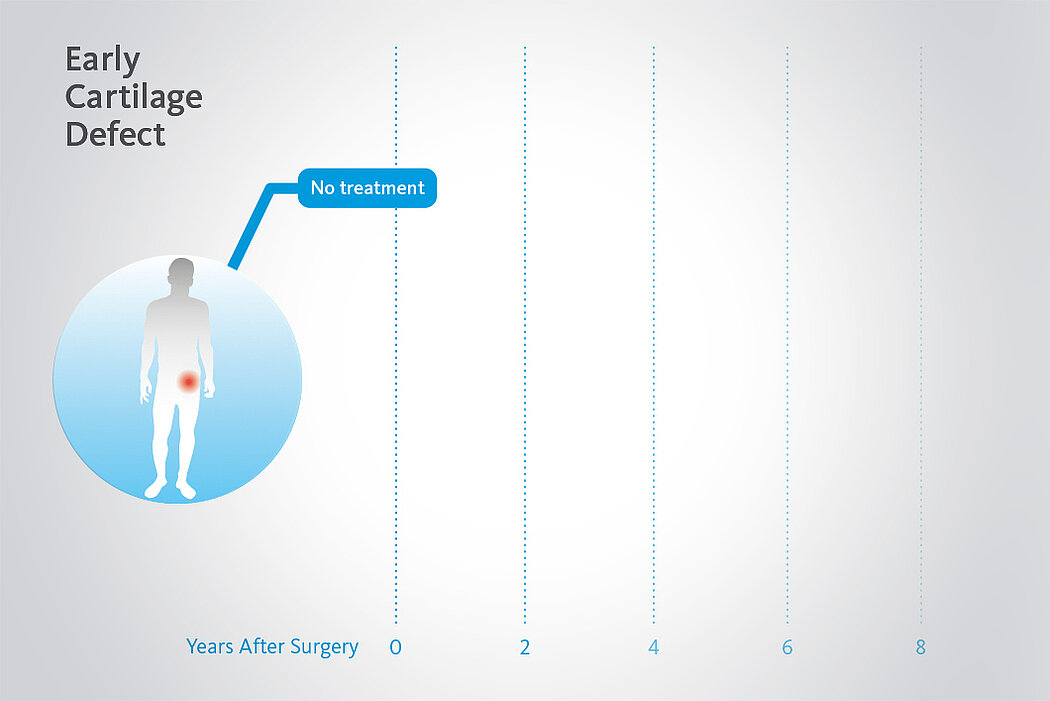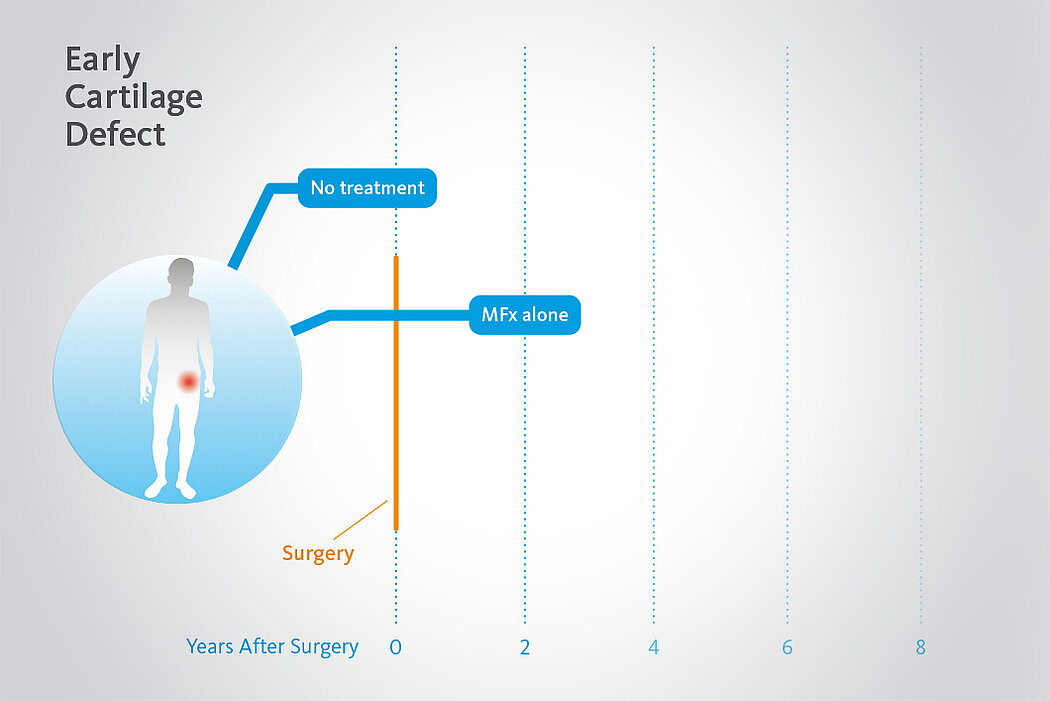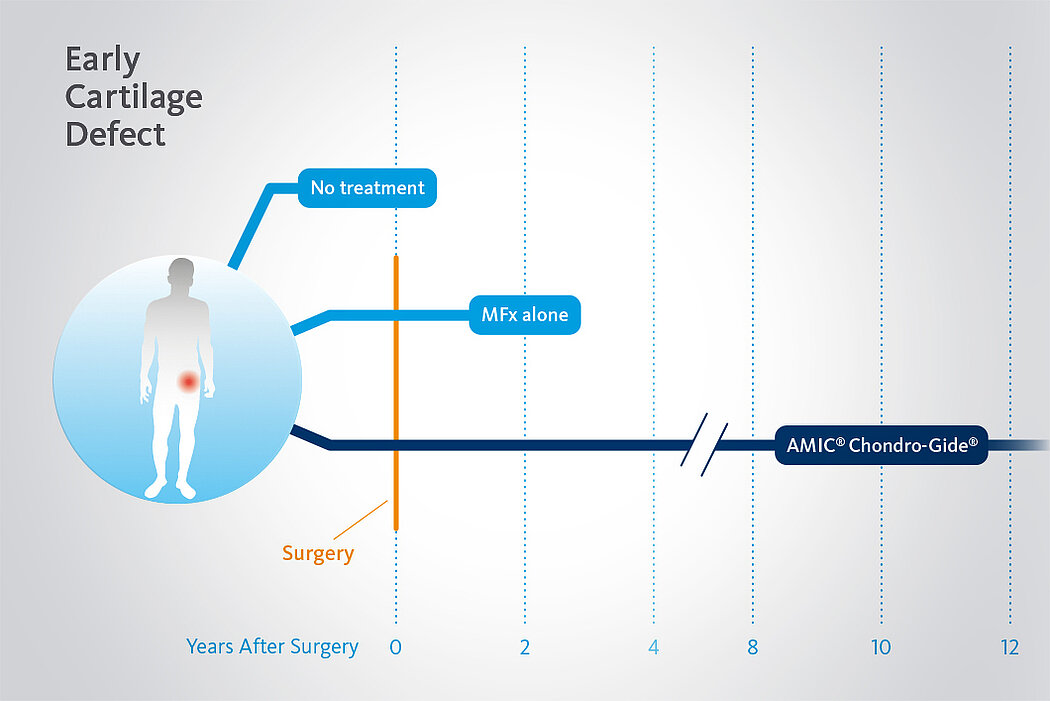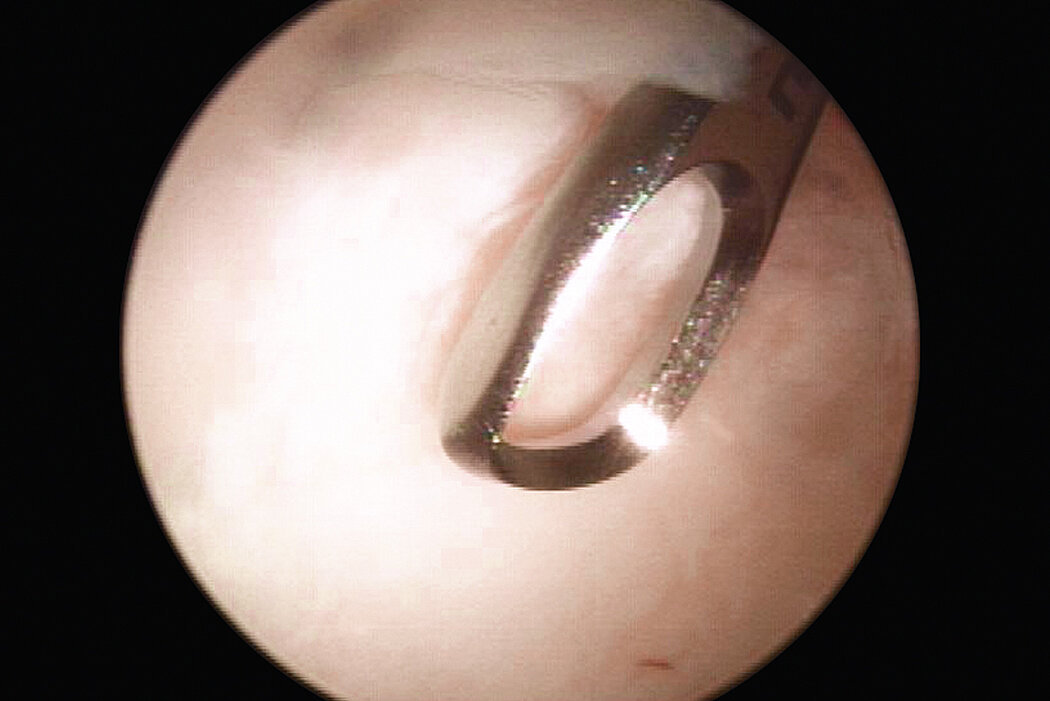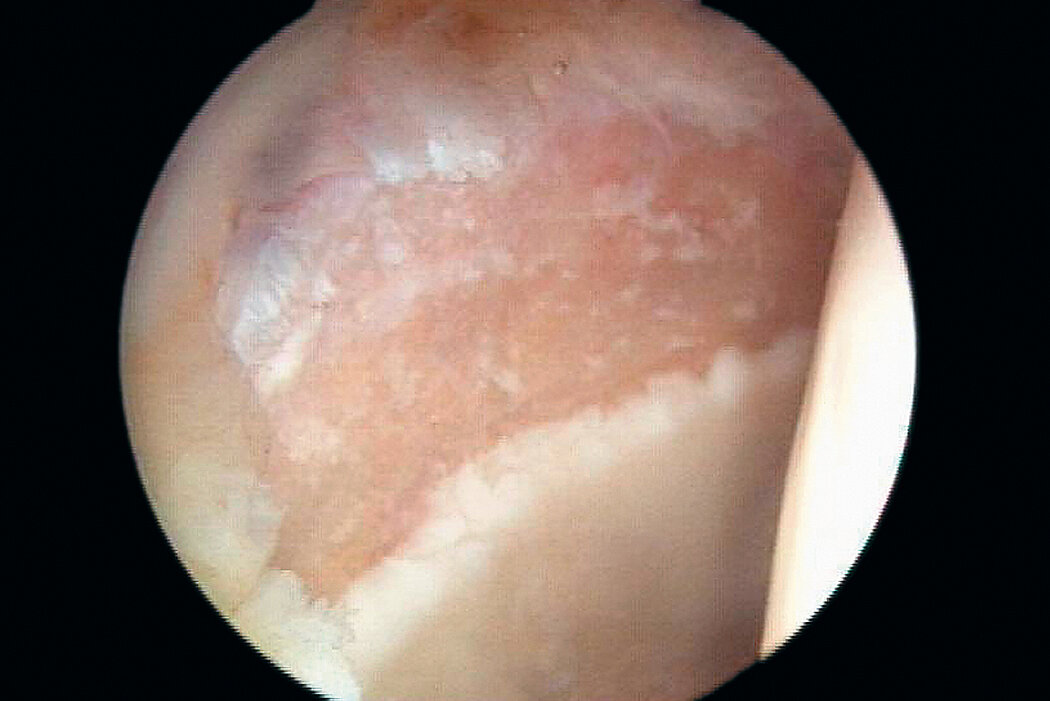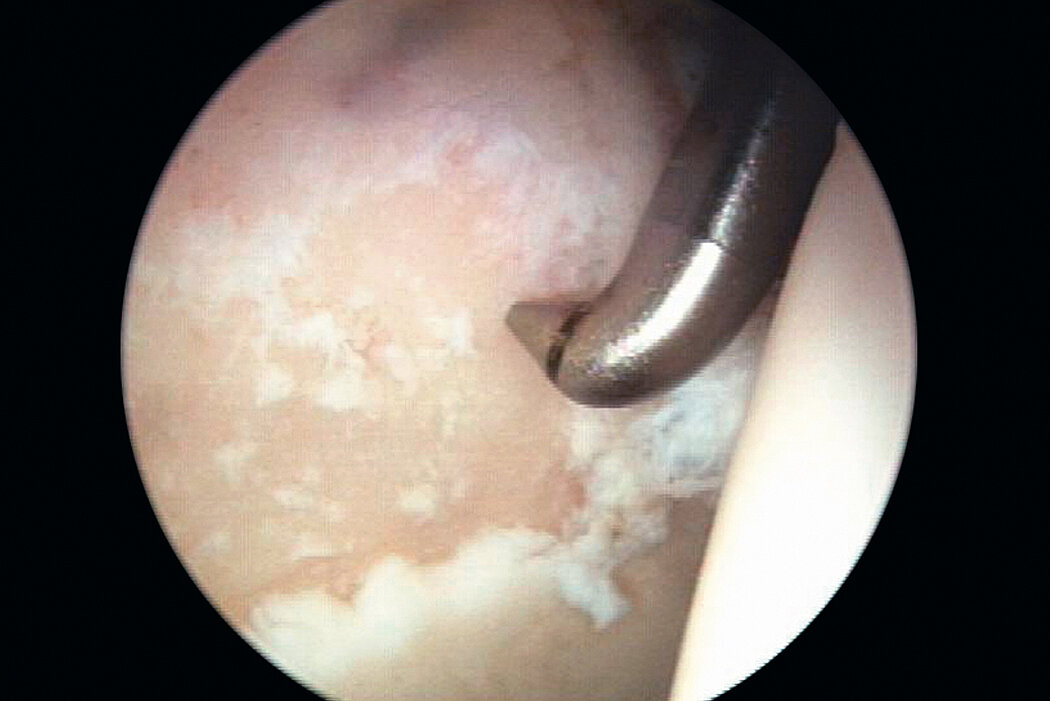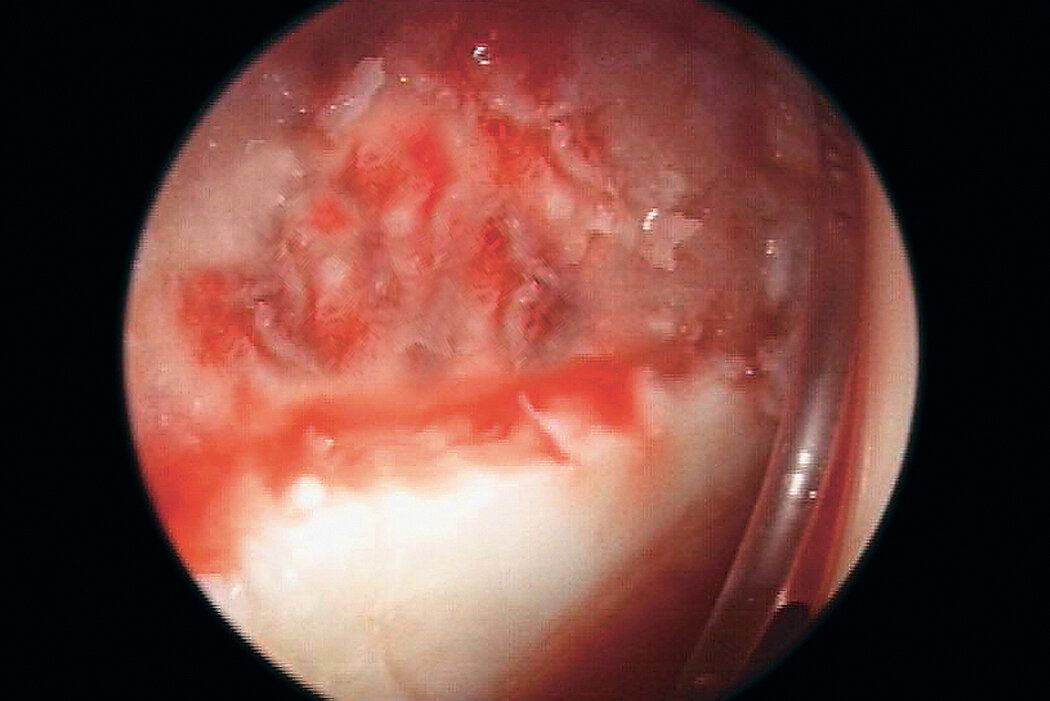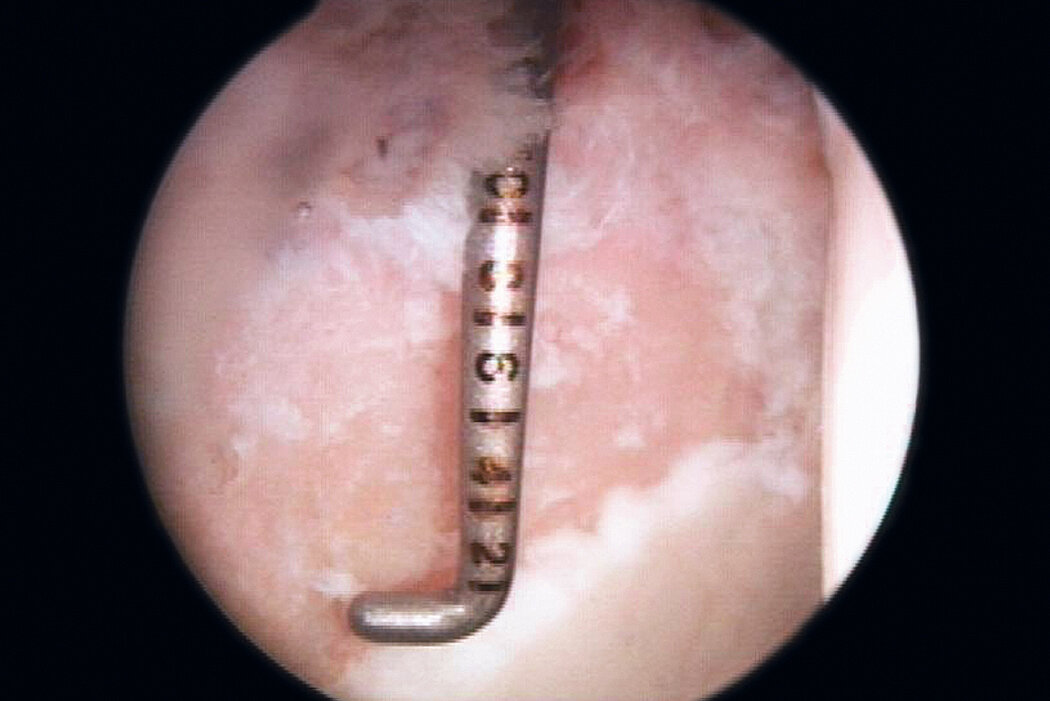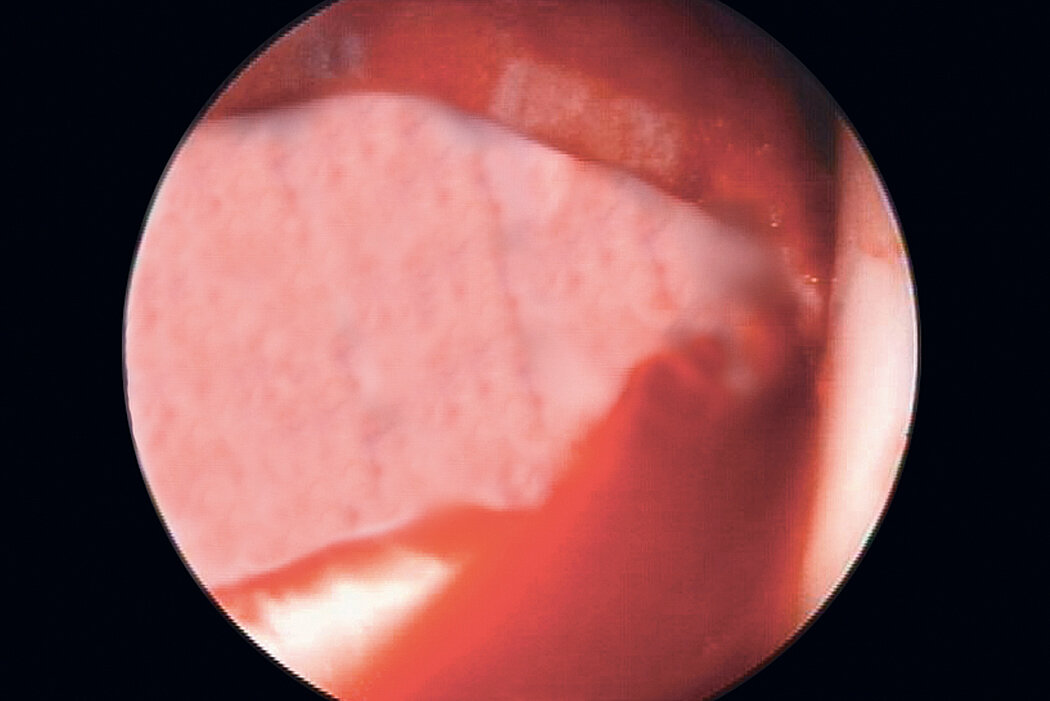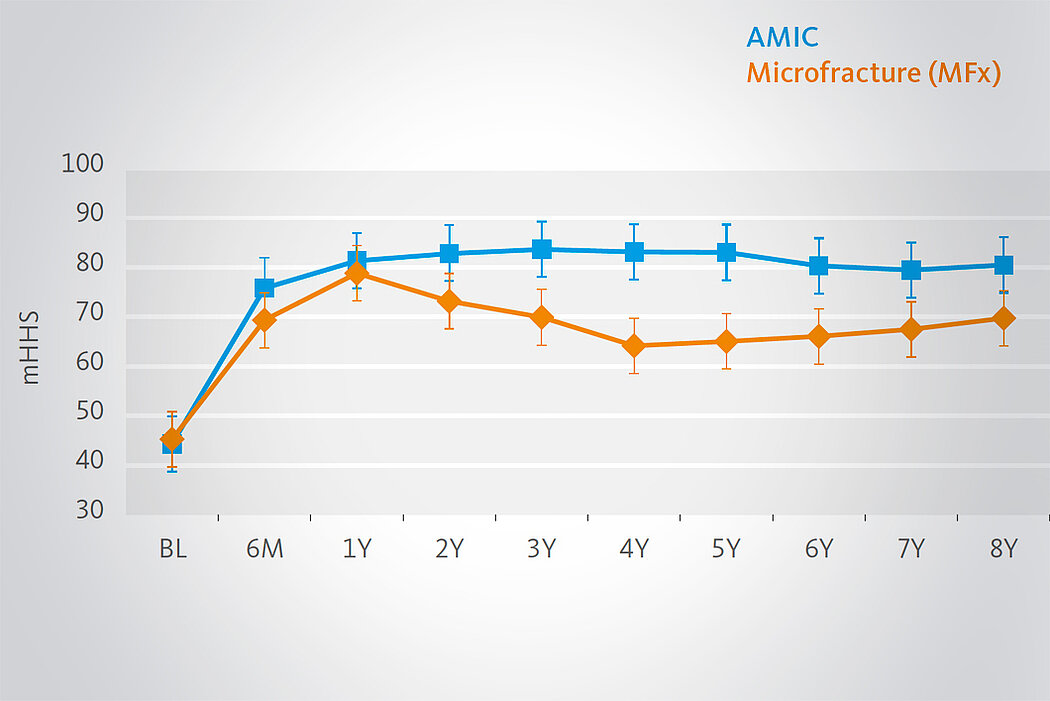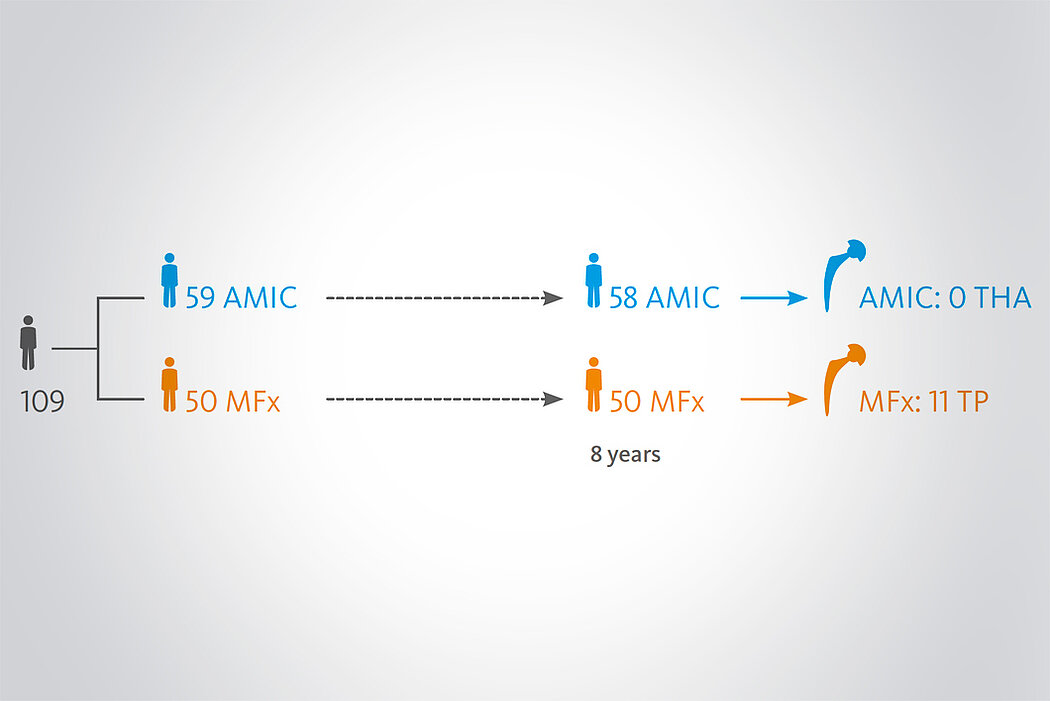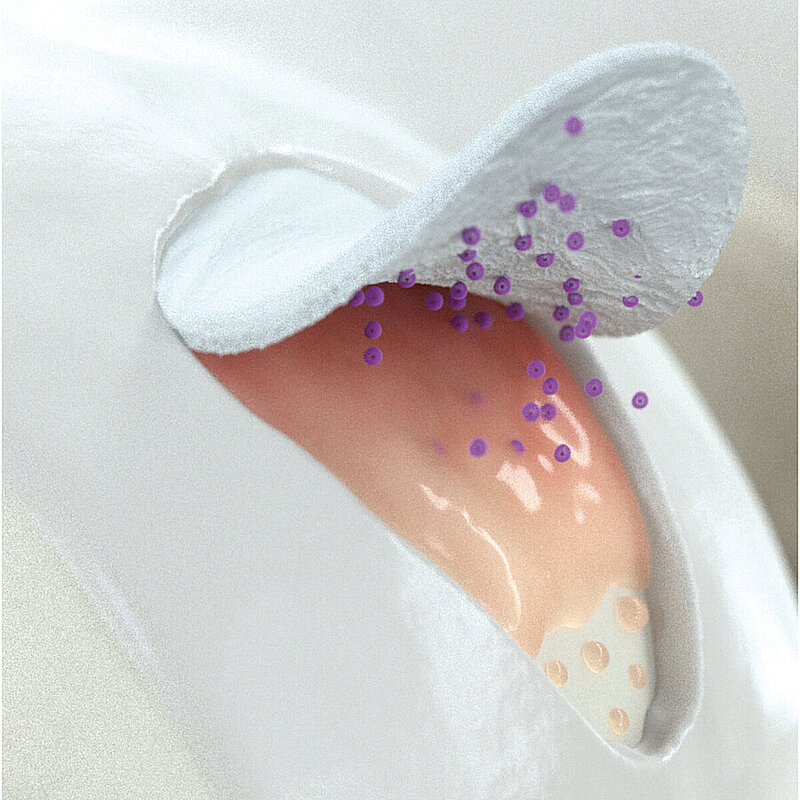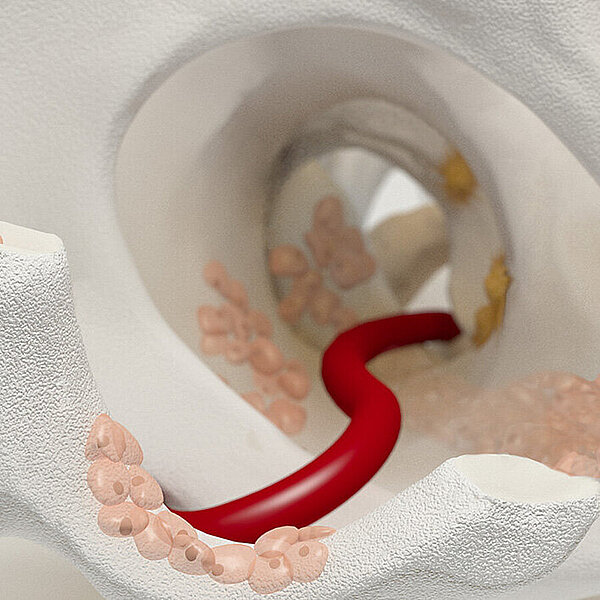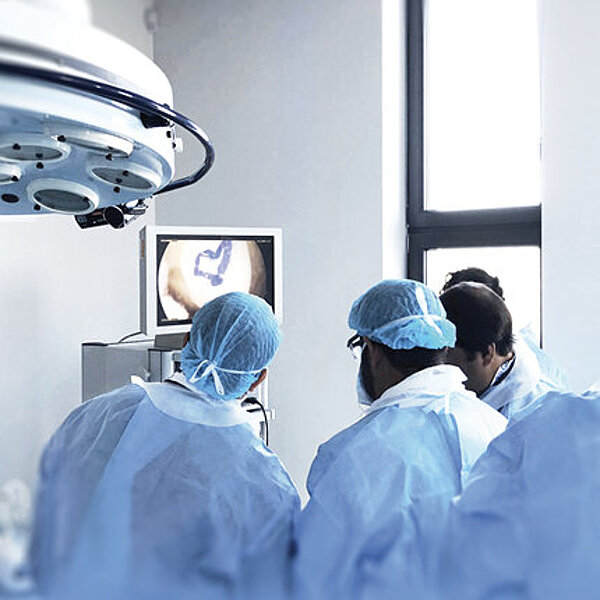AMIC® Chondro-Gide® nell'anca

I difetti condrali nell’anca dovuti a trauma, osteonecrosi, lacerazioni labiali e altre cause possono risultare in severe disfunzioni e dolori articolari. Il Conflitto Femoro Acetabolare (FAI) è un’altra causa comune di difetti e danno localizzati della cartilagine che richiede un’artroscopia dell’anca1.
Ritardare o evitare la sostituzione totale dell’anca è ora possibile
La cartilagine danneggiata ha limitate capacità di autoguarigione. Se lasciata non trattata, il danno può peggiorare nel tempo. Con un trattamento artroscopico minimamente invasivo per difetti condrali nell’anca, ora è possibile preservare la cartilagine dell’anca e ritardare e a volte anche evitare la sostituzione totale dell’anca1.
AMIC® Chondro-Gide® per una riparazione efficace della cartilagine
AMIC® Chondro-Gide® è una procedura minimamente invasiva a singolo step che usa la stimolazione del midollo osseo combinata con Chondro-Gide® nella riparazione dei difetti cartilaginei di ogni dimensione. Sviluppata da Geistlich Surgery in collaborazione con Opinion Leaders europei, AMIC® Chondro-Gide® è un trattamento efficace e economico2,3 per la riparazione della cartilagine dell’anca danneggiata, alleviando o prevenendo il dolore e rallentando la progressione del danno.
Con la sua speciale stuttura doppio strato, Chondro-Gide® fornisce un ambiente protettivo che favorisce la crescita di nuova cartilagine4,5.
- Membrana di collagene naturale I/III doppio strato4
- Biocompatibile e naturalmente riassorbibile4
- Facile da maneggiare: flessibile e resistente alle lacerazioni4
- Può essere incollata o suturata in situ4
- Compatibile con varie tecniche di rigenerazione tissutale6
- Procedura one-step4
- Pronta per l’uso4
References
- MARQUEZ-LARA, A. et al., 2016, Arthroscopic Management of Hip Chondral Defects: A Systematic Review of the Literature. Arthroscopy: The Journal of Arthroscopic & Related Surgery. 2016. Vol. 32, no. 7, p. 1435-1443. DOI 10.1016/j.arthro.2016.01.058. Elsevier BV (Review).
- SCHIAVONE PANNI, A., et al. Good clinical results with autologous matrix-induced chondrogenesis (AMIC) technique in large knee chondral defects. Knee Surg Sports Traumatol Arthrosc, 2018 Apr 26(4):1130-36 (Clinical study).
- WALTHER, M., et al. Scaffold based reconstruction of focal full thickness talar cartilage defects. Clinical Research on Foot & Ankle, 2013, 1-5. (Clinical study).
- Geistlich Pharma AG data on file (Pre-clinical Study)
- GILLE, J., et al. Cell-Laden and Cell-Free Matrix-Induced-Chondrogenesis versus Microfracture for the Treatment of Articular Cartilage Defects: A Histological and Biomechanical Study in Sheep. Cartilage OnlineFirst, January 7, 2010, doi:10.1177/1947603509358721 (Pre-clinical study)
- KRAMER, J., et al. In vivo matrix-guided human mesenchymal stem cells. Cell Mol Life Sci, Mar 2006, 3(5), 616-626. (Clinical study)
- FONTANA, A. and DE GIROLAMO, L., 2015, Sustained 5-year benefit of autologous matrix-induced chondrogenesis for femoral acetabular impingement-induced chondral lesions compared with microfracture treatment. The Bone & Joint Journal. 2015. Vol. 97-B, no. 5, p. 628-635. DOI 10.1302/0301-620x.97b5.35076. British Editorial Society of Bone & Joint Surgery (Clinical study).
- DE GIROLAMO, L., et al., Autologous Matrix-Induced Chondrogenesis (AMIC) and AMIC Enhanced by Autologous Concentrated Bone Marrow Aspirate (BMAC) Allow for Stable Clinical and Functional Improvements at up to 9 Years Follow-Up: Results from a Randomized Controlled Study. Journal of Clinical Medicine. 2019. Vol. 8, no. 3, p. 392. DOI 10.3390/jcm8030392. MDPI AG (Clinical Study)
- Chondro-Gide® IFU 2019, Geistlich Pharma AG
- FICKERT, S. et al., 2017, Biologic Reconstruction of Full Sized Cartilage Defects of the Hip: A Guideline from the DGOU Group “Clinical Tissue Regeneration” and the Hip Committee of the AGA. Zeitschrift für Orthop.die und Unfallchirurgie. 2017. Vol. 155, no. 06, p. 670-682. DOI 10.1055/s-0043-116218. Georg Thieme Verlag KG (Guideline).
- FONTANA, A. and DE GIROLAMO, L., 2015, Sustained 5-year benefit of autologous matrix-induced chondrogenesis for femoral acetabular impingement-induced chondral lesions compared with microfracture treatment. The Bone & Joint Journal. 2015. Vol. 97-B, no. 5, p. 628-635. DOI 10.1302/0301-620x.97b5.35076. British Editorial Society of Bone & Joint Surgery (Clinical study).
- KAISER, N., et al. Clinical results 10 years after AMIC in the knee. Swiss Med Wkly, 2015, 145 (Suppl 210), 43S. (Clinical study).
- DE GIROLAMO, L., et al., 2018, Acetabular Chondral Lesions Associated With Femoroacetabular Impingement Treated by Autologous Matrix-Induced Chondrogenesis or Microfracture: A Comparative Study at 8-Year Follow-Up. Arthroscopy: The Journal of Arthroscopic & Related Surgery. 2018. Vol. 34, no. 11, p. 3012-3023. DOI 10.1016/j.arthro.2018.05.035. Elsevier BV (Clinical study).
- MANCINI, D., and FONTANA, A., 2014, Five-year results of arthroscopic techniques for the treatment of acetabular chondral lesions in femoroacetabular impingement. International Orthopaedics. 2014. Vol. 38, no. 10, p. 2057-2064. DOI 10.1007/s00264-014-2403-1. Springer Science and Business Media LLC (Clinical study).
References
- MARQUEZ-LARA, A. et al., 2016, Arthroscopic Management of Hip Chondral Defects: A Systematic Review of the Literature. Arthroscopy: The Journal of Arthroscopic & Related Surgery. 2016. Vol. 32, no. 7, p. 1435-1443. DOI 10.1016/j.arthro.2016.01.058. Elsevier BV (Review).
- SCHIAVONE PANNI, A., et al. Good clinical results with autologous matrix-induced chondrogenesis (AMIC) technique in large knee chondral defects. Knee Surg Sports Traumatol Arthrosc, 2018 Apr 26(4):1130-36 (Clinical study).
- WALTHER, M., et al. Scaffold based reconstruction of focal full thickness talar cartilage defects. Clinical Research on Foot & Ankle, 2013, 1-5. (Clinical study).
- Geistlich Pharma AG data on file (Pre-clinical Study)
- GILLE, J., et al. Cell-Laden and Cell-Free Matrix-Induced-Chondrogenesis versus Microfracture for the Treatment of Articular Cartilage Defects: A Histological and Biomechanical Study in Sheep. Cartilage OnlineFirst, January 7, 2010, doi:10.1177/1947603509358721 (Pre-clinical study)
- KRAMER, J., et al. In vivo matrix-guided human mesenchymal stem cells. Cell Mol Life Sci, Mar 2006, 3(5), 616-626. (Clinical study)
- FONTANA, A. and DE GIROLAMO, L., 2015, Sustained 5-year benefit of autologous matrix-induced chondrogenesis for femoral acetabular impingement-induced chondral lesions compared with microfracture treatment. The Bone & Joint Journal. 2015. Vol. 97-B, no. 5, p. 628-635. DOI 10.1302/0301-620x.97b5.35076. British Editorial Society of Bone & Joint Surgery (Clinical study).
- DE GIROLAMO, L., et al., Autologous Matrix-Induced Chondrogenesis (AMIC) and AMIC Enhanced by Autologous Concentrated Bone Marrow Aspirate (BMAC) Allow for Stable Clinical and Functional Improvements at up to 9 Years Follow-Up: Results from a Randomized Controlled Study. Journal of Clinical Medicine. 2019. Vol. 8, no. 3, p. 392. DOI 10.3390/jcm8030392. MDPI AG (Clinical Study)
- Chondro-Gide® IFU 2019, Geistlich Pharma AG
- FICKERT, S. et al., 2017, Biologic Reconstruction of Full Sized Cartilage Defects of the Hip: A Guideline from the DGOU Group “Clinical Tissue Regeneration” and the Hip Committee of the AGA. Zeitschrift für Orthop.die und Unfallchirurgie. 2017. Vol. 155, no. 06, p. 670-682. DOI 10.1055/s-0043-116218. Georg Thieme Verlag KG (Guideline).
- FONTANA, A. and DE GIROLAMO, L., 2015, Sustained 5-year benefit of autologous matrix-induced chondrogenesis for femoral acetabular impingement-induced chondral lesions compared with microfracture treatment. The Bone & Joint Journal. 2015. Vol. 97-B, no. 5, p. 628-635. DOI 10.1302/0301-620x.97b5.35076. British Editorial Society of Bone & Joint Surgery (Clinical study).
- KAISER, N., et al. Clinical results 10 years after AMIC in the knee. Swiss Med Wkly, 2015, 145 (Suppl 210), 43S. (Clinical study).
- DE GIROLAMO, L., et al., 2018, Acetabular Chondral Lesions Associated With Femoroacetabular Impingement Treated by Autologous Matrix-Induced Chondrogenesis or Microfracture: A Comparative Study at 8-Year Follow-Up. Arthroscopy: The Journal of Arthroscopic & Related Surgery. 2018. Vol. 34, no. 11, p. 3012-3023. DOI 10.1016/j.arthro.2018.05.035. Elsevier BV (Clinical study).
- MANCINI, D., and FONTANA, A., 2014, Five-year results of arthroscopic techniques for the treatment of acetabular chondral lesions in femoroacetabular impingement. International Orthopaedics. 2014. Vol. 38, no. 10, p. 2057-2064. DOI 10.1007/s00264-014-2403-1. Springer Science and Business Media LLC (Clinical study).
Video della tecnica AMIC® nell’anca come descritto dal Prof. Andrea Fontana
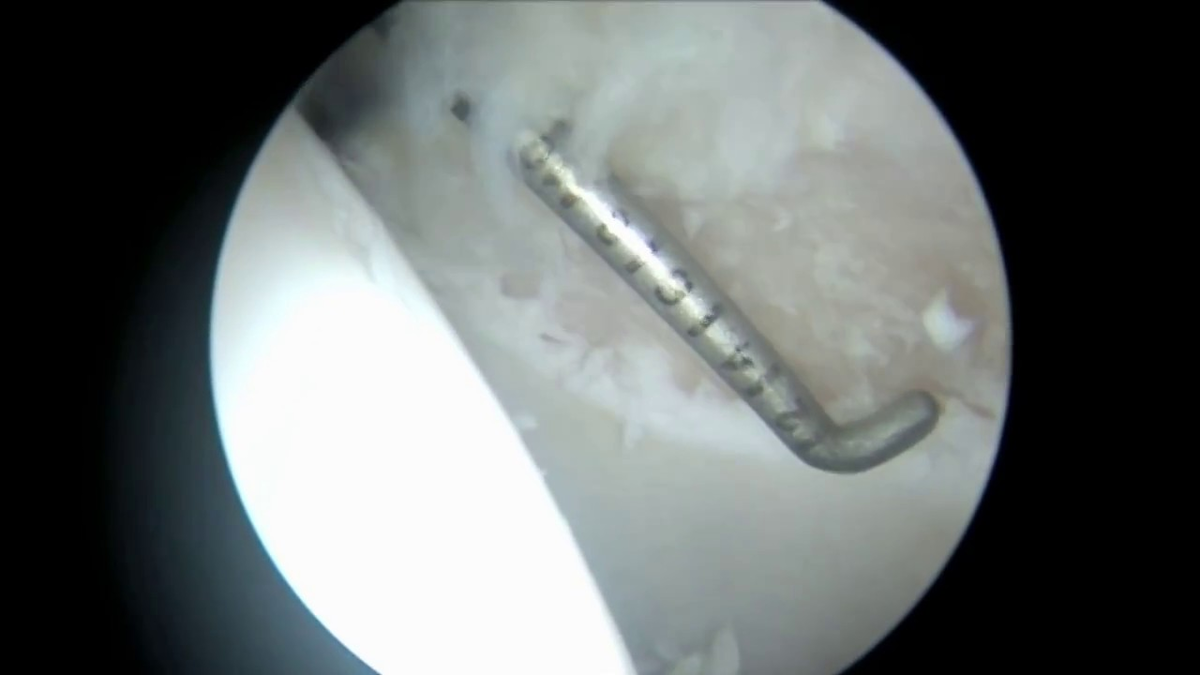
Evidenza clinica - AMIC nell'anca
Come lavora Chondro-Gide®
Chondro-Gide® fornisce una copertura protettiva e mantiene nel sito le cellule rilasciate dall’osso o introdotte nel difetto. Completa il trattamento rigenerativo per le lesioni condrali e osteocondrali. Mentre avvolge il difetto e le cellule al suo interno durante la fase iniziale del processo di guarigione, Chondro-Gide® riassorbe in circa 4 mesi1 e viene sostituita da tessuto nativo
Vantaggi a lungo termine di AMIC® Chondro-Gide® vs MFx
L’uso di Chondro-Gide® nell’anca è ben definito. Dati di oltre 8 anni dopo la chirurgia dimostrano chiaramnte i vantaggi a lungo termine della AMIC® Chondro-Gide® comparata alle Micro Fratture (MFx) da sole nei difetti acetabolari2,3,4. De Girolamo et al.3,5 in uno studio con 109 pazienti hanno comparato le sole MFx con AMIC® Chondro-Gide®. Pazienti con difetti condrali nell’anca a cui erano associati FAIs, venivano trattati con AMIC® Chondro-Gide® o MFX. Non c’erano differenze significative di età o dimensioni del difetto tra i due gruppi di pazienti.
References
- MARQUEZ-LARA, A. et al., 2016, Arthroscopic Management of Hip Chondral Defects: A Systematic Review of the Literature. Arthroscopy: The Journal of Arthroscopic & Related Surgery. 2016. Vol. 32, no. 7, p. 1435-1443. DOI 10.1016/j.arthro.2016.01.058. Elsevier BV (Review).
- SCHIAVONE PANNI, A., et al. Good clinical results with autologous matrix-induced chondrogenesis (AMIC) technique in large knee chondral defects. Knee Surg Sports Traumatol Arthrosc, 2018 Apr 26(4):1130-36 (Clinical study).
- WALTHER, M., et al. Scaffold based reconstruction of focal full thickness talar cartilage defects. Clinical Research on Foot & Ankle, 2013, 1-5. (Clinical study).
- Geistlich Pharma AG data on file (Pre-clinical Study)
- GILLE, J., et al. Cell-Laden and Cell-Free Matrix-Induced-Chondrogenesis versus Microfracture for the Treatment of Articular Cartilage Defects: A Histological and Biomechanical Study in Sheep. Cartilage OnlineFirst, January 7, 2010, doi:10.1177/1947603509358721 (Pre-clinical study)
- KRAMER, J., et al. In vivo matrix-guided human mesenchymal stem cells. Cell Mol Life Sci, Mar 2006, 3(5), 616-626. (Clinical study)
- FONTANA, A. and DE GIROLAMO, L., 2015, Sustained 5-year benefit of autologous matrix-induced chondrogenesis for femoral acetabular impingement-induced chondral lesions compared with microfracture treatment. The Bone & Joint Journal. 2015. Vol. 97-B, no. 5, p. 628-635. DOI 10.1302/0301-620x.97b5.35076. British Editorial Society of Bone & Joint Surgery (Clinical study).
- DE GIROLAMO, L., et al., Autologous Matrix-Induced Chondrogenesis (AMIC) and AMIC Enhanced by Autologous Concentrated Bone Marrow Aspirate (BMAC) Allow for Stable Clinical and Functional Improvements at up to 9 Years Follow-Up: Results from a Randomized Controlled Study. Journal of Clinical Medicine. 2019. Vol. 8, no. 3, p. 392. DOI 10.3390/jcm8030392. MDPI AG (Clinical Study)
- Chondro-Gide® IFU 2019, Geistlich Pharma AG
- FICKERT, S. et al., 2017, Biologic Reconstruction of Full Sized Cartilage Defects of the Hip: A Guideline from the DGOU Group “Clinical Tissue Regeneration” and the Hip Committee of the AGA. Zeitschrift für Orthop.die und Unfallchirurgie. 2017. Vol. 155, no. 06, p. 670-682. DOI 10.1055/s-0043-116218. Georg Thieme Verlag KG (Guideline).
- FONTANA, A. and DE GIROLAMO, L., 2015, Sustained 5-year benefit of autologous matrix-induced chondrogenesis for femoral acetabular impingement-induced chondral lesions compared with microfracture treatment. The Bone & Joint Journal. 2015. Vol. 97-B, no. 5, p. 628-635. DOI 10.1302/0301-620x.97b5.35076. British Editorial Society of Bone & Joint Surgery (Clinical study).
- KAISER, N., et al. Clinical results 10 years after AMIC in the knee. Swiss Med Wkly, 2015, 145 (Suppl 210), 43S. (Clinical study).
- DE GIROLAMO, L., et al., 2018, Acetabular Chondral Lesions Associated With Femoroacetabular Impingement Treated by Autologous Matrix-Induced Chondrogenesis or Microfracture: A Comparative Study at 8-Year Follow-Up. Arthroscopy: The Journal of Arthroscopic & Related Surgery. 2018. Vol. 34, no. 11, p. 3012-3023. DOI 10.1016/j.arthro.2018.05.035. Elsevier BV (Clinical study).
- MANCINI, D., and FONTANA, A., 2014, Five-year results of arthroscopic techniques for the treatment of acetabular chondral lesions in femoroacetabular impingement. International Orthopaedics. 2014. Vol. 38, no. 10, p. 2057-2064. DOI 10.1007/s00264-014-2403-1. Springer Science and Business Media LLC (Clinical study).
AMIC® vs MACI®
Uno studio a 5 anni di Mancini e Fontana compara I risultati ottenuti con le tecniche AMIC® Chondro-Gide® e MACI (Matrix-Induced autologous chondrocyte implantation) per il trattamento di difetti condrali acetabolari di media grandezza5. AMIC offre vantaggi aggiuntivi essendo una procedura minimamente invasiva a singolo step che può ridurre il tempo totale di trattamento e minimizza la morbilità.
Per maggiori dettagli su Chondro-Gide®, tecniche chirurgiche e approfondimenti clinici, scaricare la brochure, scaricare la brochure.
References
- MARQUEZ-LARA, A. et al., 2016, Arthroscopic Management of Hip Chondral Defects: A Systematic Review of the Literature. Arthroscopy: The Journal of Arthroscopic & Related Surgery. 2016. Vol. 32, no. 7, p. 1435-1443. DOI 10.1016/j.arthro.2016.01.058. Elsevier BV (Review).
- SCHIAVONE PANNI, A., et al. Good clinical results with autologous matrix-induced chondrogenesis (AMIC) technique in large knee chondral defects. Knee Surg Sports Traumatol Arthrosc, 2018 Apr 26(4):1130-36 (Clinical study).
- WALTHER, M., et al. Scaffold based reconstruction of focal full thickness talar cartilage defects. Clinical Research on Foot & Ankle, 2013, 1-5. (Clinical study).
- Geistlich Pharma AG data on file (Pre-clinical Study)
- GILLE, J., et al. Cell-Laden and Cell-Free Matrix-Induced-Chondrogenesis versus Microfracture for the Treatment of Articular Cartilage Defects: A Histological and Biomechanical Study in Sheep. Cartilage OnlineFirst, January 7, 2010, doi:10.1177/1947603509358721 (Pre-clinical study)
- KRAMER, J., et al. In vivo matrix-guided human mesenchymal stem cells. Cell Mol Life Sci, Mar 2006, 3(5), 616-626. (Clinical study)
- FONTANA, A. and DE GIROLAMO, L., 2015, Sustained 5-year benefit of autologous matrix-induced chondrogenesis for femoral acetabular impingement-induced chondral lesions compared with microfracture treatment. The Bone & Joint Journal. 2015. Vol. 97-B, no. 5, p. 628-635. DOI 10.1302/0301-620x.97b5.35076. British Editorial Society of Bone & Joint Surgery (Clinical study).
- DE GIROLAMO, L., et al., Autologous Matrix-Induced Chondrogenesis (AMIC) and AMIC Enhanced by Autologous Concentrated Bone Marrow Aspirate (BMAC) Allow for Stable Clinical and Functional Improvements at up to 9 Years Follow-Up: Results from a Randomized Controlled Study. Journal of Clinical Medicine. 2019. Vol. 8, no. 3, p. 392. DOI 10.3390/jcm8030392. MDPI AG (Clinical Study)
- Chondro-Gide® IFU 2019, Geistlich Pharma AG
- FICKERT, S. et al., 2017, Biologic Reconstruction of Full Sized Cartilage Defects of the Hip: A Guideline from the DGOU Group “Clinical Tissue Regeneration” and the Hip Committee of the AGA. Zeitschrift für Orthop.die und Unfallchirurgie. 2017. Vol. 155, no. 06, p. 670-682. DOI 10.1055/s-0043-116218. Georg Thieme Verlag KG (Guideline).
- FONTANA, A. and DE GIROLAMO, L., 2015, Sustained 5-year benefit of autologous matrix-induced chondrogenesis for femoral acetabular impingement-induced chondral lesions compared with microfracture treatment. The Bone & Joint Journal. 2015. Vol. 97-B, no. 5, p. 628-635. DOI 10.1302/0301-620x.97b5.35076. British Editorial Society of Bone & Joint Surgery (Clinical study).
- KAISER, N., et al. Clinical results 10 years after AMIC in the knee. Swiss Med Wkly, 2015, 145 (Suppl 210), 43S. (Clinical study).
- DE GIROLAMO, L., et al., 2018, Acetabular Chondral Lesions Associated With Femoroacetabular Impingement Treated by Autologous Matrix-Induced Chondrogenesis or Microfracture: A Comparative Study at 8-Year Follow-Up. Arthroscopy: The Journal of Arthroscopic & Related Surgery. 2018. Vol. 34, no. 11, p. 3012-3023. DOI 10.1016/j.arthro.2018.05.035. Elsevier BV (Clinical study).
- MANCINI, D., and FONTANA, A., 2014, Five-year results of arthroscopic techniques for the treatment of acetabular chondral lesions in femoroacetabular impingement. International Orthopaedics. 2014. Vol. 38, no. 10, p. 2057-2064. DOI 10.1007/s00264-014-2403-1. Springer Science and Business Media LLC (Clinical study).


